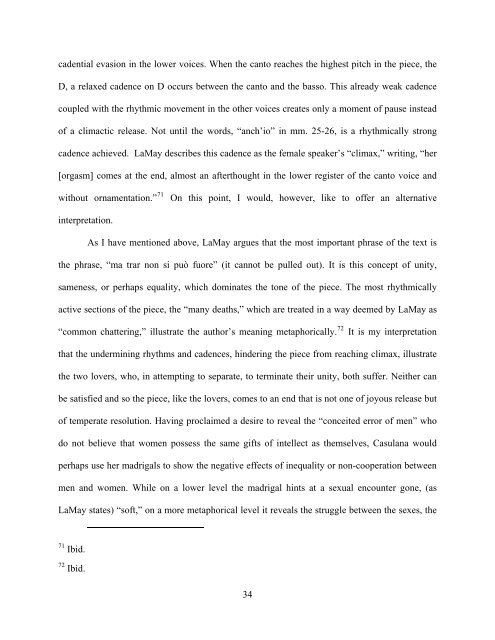Download - D-Scholarship@Pitt - University of Pittsburgh
Download - D-Scholarship@Pitt - University of Pittsburgh
Download - D-Scholarship@Pitt - University of Pittsburgh
Create successful ePaper yourself
Turn your PDF publications into a flip-book with our unique Google optimized e-Paper software.
cadential evasion in the lower voices. When the canto reaches the highest pitch in the piece, the<br />
D, a relaxed cadence on D occurs between the canto and the basso. This already weak cadence<br />
coupled with the rhythmic movement in the other voices creates only a moment <strong>of</strong> pause instead<br />
<strong>of</strong> a climactic release. Not until the words, “anch’io” in mm. 25-26, is a rhythmically strong<br />
cadence achieved. LaMay describes this cadence as the female speaker’s “climax,” writing, “her<br />
[orgasm] comes at the end, almost an afterthought in the lower register <strong>of</strong> the canto voice and<br />
without ornamentation.” 71 On this point, I would, however, like to <strong>of</strong>fer an alternative<br />
interpretation.<br />
As I have mentioned above, LaMay argues that the most important phrase <strong>of</strong> the text is<br />
the phrase, “ma trar non si può fuore” (it cannot be pulled out). It is this concept <strong>of</strong> unity,<br />
sameness, or perhaps equality, which dominates the tone <strong>of</strong> the piece. The most rhythmically<br />
active sections <strong>of</strong> the piece, the “many deaths,” which are treated in a way deemed by LaMay as<br />
“common chattering,” illustrate the author’s meaning metaphorically. 72 It is my interpretation<br />
that the undermining rhythms and cadences, hindering the piece from reaching climax, illustrate<br />
the two lovers, who, in attempting to separate, to terminate their unity, both suffer. Neither can<br />
be satisfied and so the piece, like the lovers, comes to an end that is not one <strong>of</strong> joyous release but<br />
<strong>of</strong> temperate resolution. Having proclaimed a desire to reveal the “conceited error <strong>of</strong> men” who<br />
do not believe that women possess the same gifts <strong>of</strong> intellect as themselves, Casulana would<br />
perhaps use her madrigals to show the negative effects <strong>of</strong> inequality or non-cooperation between<br />
men and women. While on a lower level the madrigal hints at a sexual encounter gone, (as<br />
LaMay states) “s<strong>of</strong>t,” on a more metaphorical level it reveals the struggle between the sexes, the<br />
71 Ibid.<br />
72 Ibid.<br />
34















